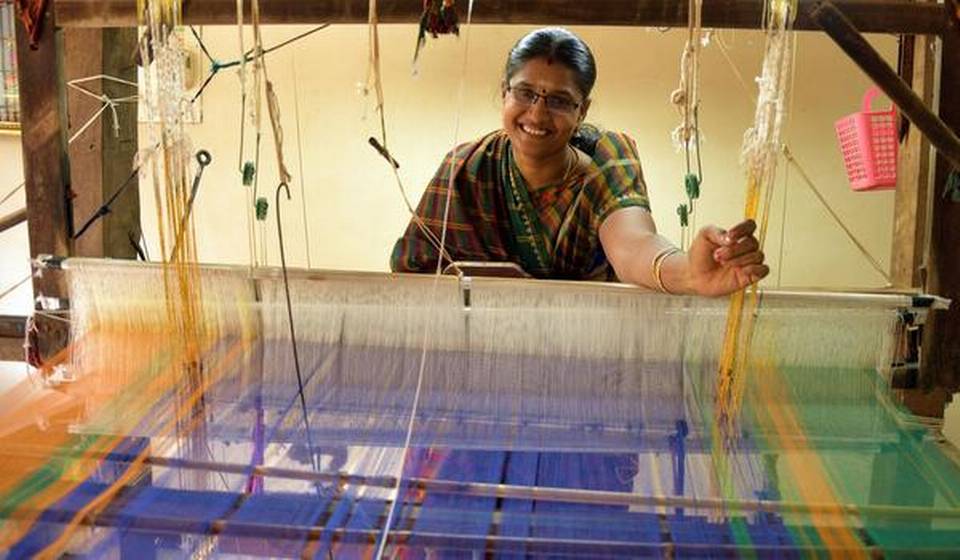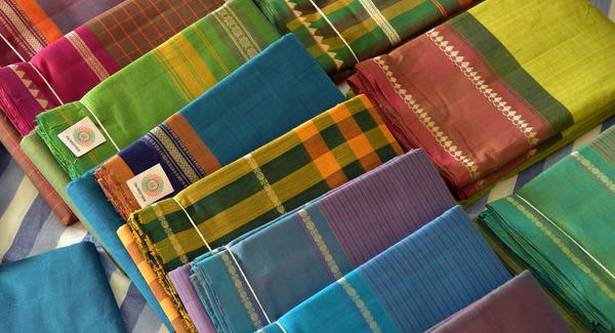
Kandangi weavers are jubilant as they hope the recent GI Tag to the distinctive cotton sari will bring back its fame
In a rented apartment on Alangudiyar Street in Karaikudi, Sivaganga district, where the Amarar Rajeev Gandhi Handloom Weavers Cooperative Production and Sales Society Limited has its office, the mood is jubilant. Six years after the cooperative applied for a Geographical Indication (GI) tag from the Geographical Indications Registry in Chennai for its distinctive Kandangi cotton sari, the approval has come through. “The phones haven’t stopped ringing,” says J Hema Jayamurugan, president of the society. “After years of being overlooked, suddenly everyone wants to know our story.”
_________________________
- The Kandangi sari was one of three heritage products from Tamil Nadu that were granted the GI tag in late August; Dindigul’s handmade locks and Palani’s Panchamirtham, a sweet prasadam (offering) unique to the Arulmigu Dhandayuthapani Swamy Temple there, were the other two.
- The GI tag is granted for a period of 10 years. Renewal will depend on the standards being maintained over the years.
________________________
Weaving was brought to this region in the 17th century, when the present-day districts of Sivaganga, Pudukottai and Ramanathapuram were ruled by the Sethupathy kings. Kandangi (meaning chequered in Tamil) saris were originally woven in silk (pattu Kandangi) but are now made of coarse cotton, and measure between 5.10 to 5.60 metres, with a width of 47-49 inches.
“Around 40-50 years ago, women from well-to-do families of the Nagarathar Chettiar community started asking weavers to recreate their silk sari patterns on cotton because they were easier to wear in the hot weather,” says S Palaniappan, former president of the Karaikudi cooperative, and Hema’s father. “But whether it is silk or cotton, the chief distinguishing mark of a Kandangi sari is its mub-bagham (triple) colour design.”

Woven in colours like bottle green, mustard, russet and yellows with broad borders encasing a body embellished with just stripes or checks, the Kandangi sari is a design classic. The ease with which it can be replicated could also explain why powerloom weavers and designers are selling lookalike mixed-fibre products as ‘Chettinad cotton saris’ at considerably higher prices in urban centres. “We came to know about this large-scale plagiarism only after customers started coming to us with complaints of their Kandangi saris shrinking by 2-4 inches after each wash. Since we treat our yarn (purchased in bulk from National Handloom Development Corporation in Coimbatore) rigorously to prevent shrinkage after weaving as per government norms, it became clear that poly-cotton fabric was being passed off as Kandangi to the general public,” says Palaniappan, who also worked on getting the handloom stamp of authenticity in 2016 for the co-operative’s products.
“Before the Geographical Indications of Goods (Registration and Protection) Act of 1999, no traditional product in India was protected legally with regard to its location or uniqueness,” says P Sanjai Gandhi, the Chennai-based IP lawyer who filed the application on behalf of the Karaikudi weavers’ group, under the aegis of the Department of Handloom and Textiles, Government of Tamil Nadu .“The GI tag is a like a comprehensive protection for the whole art — method of production, producers and product. A tag will definitely stop the theft of IP rights.”
____________________
- Today, many of the once desolate stately homes in Chettinad have been revived as heritage hotels. Package tours often include a day trip to Athangudi, known for its handmade tiles; to Kanadukathan, for its weaving; and Karaikudi, famous for its antique stores. Other well-known products from this area include the ‘kottan’ or palm frond baskets and fried snacks made by Chettiars.
________________________
Amarar Rajeev Gandhi Handloom Weavers Cooperative has 176 members who collectively use around 35 looms in Karaikudi. Around 90-100 Kandangi saris (currently priced at ₹868) are produced per month by mostly women weavers, as the men have drifted away to more lucrative jobs in other sectors. A majority of the stock is marketed through The Tamil Nadu Handloom Weavers’ Cooperative Society (Co-optex). “In the olden days, a weaver would be able to earn only ₹320 to weave four saris. Our members are given ₹360 per sari, which is why many of those who had left the profession are now coming back,” says Hema.
Demonstrating how the padauk wood looms operate, Hema says that most of the pre-weaving work, such as dyeing and starching the threads and transferring them to the spindles and rollers, is still manual. “We are looking to establish weaving sheds where members can use the looms as per their requirements, because the tiled floors in modern homes don’t allow us to lower the loom below the ground, and we don’t have the space for more than one or two in a standard room,” she points out.
In the nearby village of Kanadukathan, S Krishnaveni is closing a sale for 30 cotton saris at her Sri Mahalakshmi Handloom Weaving Centre. “These are Kandangi colours, but the cotton is different,” she clarifies, as she folds and stacks up the saris.
A common destination for tourists visiting Chettinad, the centre maintains separate looms for Kandangi cotton saris. “Our Kandangi cottons are sold to boutiques in cities like Chennai, Bengaluru and Hyderabad. Local customers prefer saris that look grand but don’t cost much. They feel the Kandangi cotton is a bit too plain,” says Krishnaveni.
She feels the GI tag will help to reduce the online sale of Kandangi lookalikes. “But more than the customer, standardisation will help weavers to value the beauty of their craft and product,” says Krishnaveni.
source: http://www.thehindu.com / The Hindu / Home> Life & Style> Fashion / by Nahla Nainar / September 16th, 2019